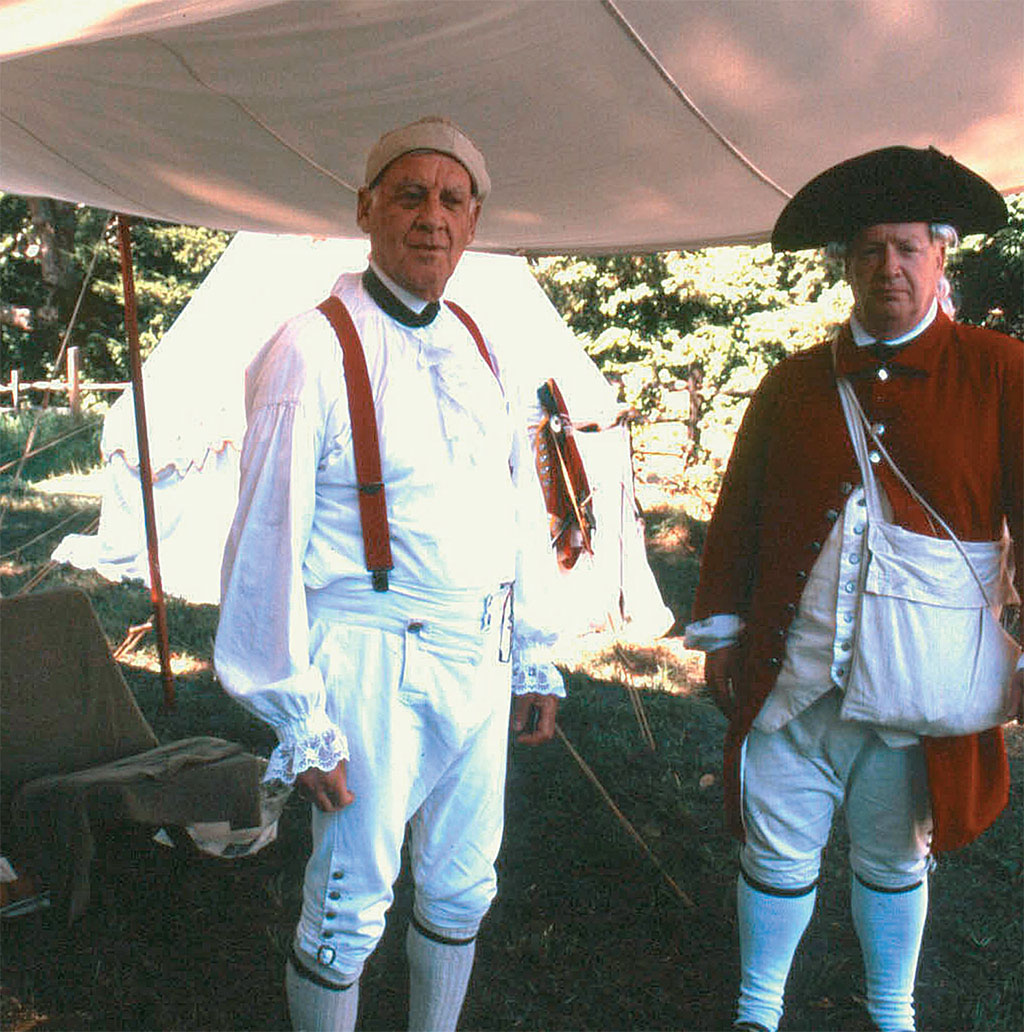
[caption id="HisMajestys10thRegimentofFootAmericanContingent_img1" align="aligncenter" width="1024"]

COURTESY OF THE 10TH REGIMENT OF FOOT, AMERICAN CONTINGENT
WHEN THE SMOKE OF MUSKET FIRE clears at Lexington Green every Patriots’ Day, the crowds of visitors cheer the fallen Minutemen, and the disdained Red Coats withdraw from the field at the annual April recreation of the War of Independence’s first skirmish. The campaign season of His Majesty’s 10th Regiment of Foot, American Contingent, has begun. After all, someone has to play the bad guys.
On both sides of the Atlantic, tens of thousands of people relive history as reenactors. Military reenactors interpret the life and times of a specific military unit, incarnating the camp life, military drills and battles of virtually every era of warfare from Roman Britain to the American Civil War. Officers, men and camp followers (women and children) virtually live their period roles in camp, with every detail of their dress, equipage, cookery, accouterments and weaponry accurate to their unit.
One of the best of these units is His Majesty’s 10th Regiment of Foot, based in Lexington, Mass. With dedication and verve, the 10th Foot re-creates a historic British regiment that saw action in the colonies through the early years of the American Revolution. From its founding 40 years ago by Colonel Vincent Kehoe, the American Contingent has sought to maintain the highest fidelity to late 18th-century regimental life—and to honor the historic regiment that they represent in the field.
[caption id="HisMajestys10thRegimentofFootAmericanContingent_img2" align="aligncenter" width="1024"]

DANA HUNTLEY
As Captain Richard Amsterdam, adjutant, describes: “Our exercise is to approach perfection, our accouterments polished to a gleaming high finish and our uniforms to be of the finest quality, our small clothes to be starched white. And anything else short of this is not 10th Foot.” In fact, they’ve been called the finest 18th-century British re-created regiment in the world, not only for their uniform, equipage and maneuvers, but also for the bearing of their officers and men.
Two companies comprise the garrison regiment: Light Infantry and Grenadiers. Most of the 10th Foot officers and soldiers live in eastern Massachusetts and southern New Hampshire—close enough to commute to monthly drills held in the Lexington Armory. There are also workshops in 18th-century kit, music rehearsals and staff meetings. During the campaign season that begins every year on Lexington Green, the regiment has a full calendar of parades, encampments and battle re-creation engagements all true in spirit and performance to the Old Corps of 1775.
The 10th Regiment of Foot began in 1685, when James II was adding a regiment to deal with the Duke of Monmouth’s rebellion. Raised as the Earl of Bath’s Regiment, it kept that name until numbers were assigned to regiments in 1751. The 10th Foot first saw active service on the continent of Europe during the War of the Grand Alliance in 1692, and won its first battle honors with Marlborough during the War of the Spanish Succession.
The regiment sailed for North America in 1767 and garrisoned forts in the Great Lakes until it was posted to Boston in the autumn of 1774. Soldiers encamped on Boston Common, and the officers were billeted in nearby homes. The Grenadier and Light Infantry companies of the 10th Foot fought in the historic skirmishes in Concord and Lexington the following April.
Through the War of Independence, the 10th Foot took part in the battles of Bunker Hill, Long Island, Germantown and Monmouth and the invasion of New York. Its last action was the defense of Newport, R.I., in 1778, before the regiment was recalled to England that autumn.
The Old Corps of the 10th Foot went on to win battle honors in the Napoleonic Wars, the Colonial Wars and the World Wars. As the British military has reorganized over the years, it became the Royal Lincolnshire Regiment and today is the 2nd Battalion, the Royal Anglian Regiment. Members are proudly known as “The Poachers,” and are now completing several years of service in Basra, Iraq.
The Royal Lincolnshire Regiment and the 10th Foot are commemorated in their award-winning regimental galleries at the Museum of Lincolnshire Life in the medieval cathedral city of Lincoln.
Though the original regiment has evolved as a unit over the years, from the American Contingent’s inception in 1968, it has always had a close relationship with The Poachers, with many exchanged honors and visits over the years. The soldiers of the 10th Foot have followed the action of the British regiment on the field in Iraq, and mourn its casualties.
For the officers, men and camp followers of the 10th Foot, being a part of living history is not a casual interest. It takes a huge personal commitment of time and expense to equip, maintain, train and reenact a military life from 1775. The payback is a tremendous sense of comradeship and belonging to something that is timeless and expressive of our own British roots.
The 10th Foot is not the only reenactor on the British side of the field. There are nearly 70 such units of British military reenactors, principally along the Atlantic coast, forming the umbrella unit, the British Brigade. There are dragoons on Long Island, Select Marksmen in Toronto and German allies in Bradenton, Fla. You can find a unit near you on the Web at www.britishbrigade.org.
The events of the 2008 campaign season for the 10th Regiment of Foot can be found on its Web site at www.tenthfoot.org. If the unit is coming to a battle or encampment near you, by all means, visit their camp. The men and women are eagerly friendly and very informative about 18th-century life. Hands across the sea, you know.





Comments